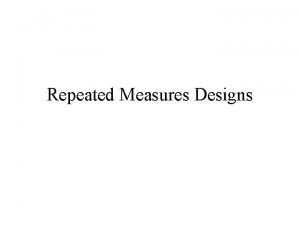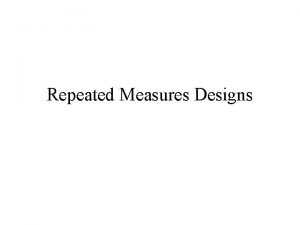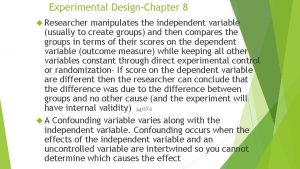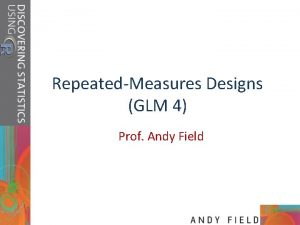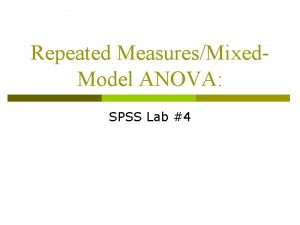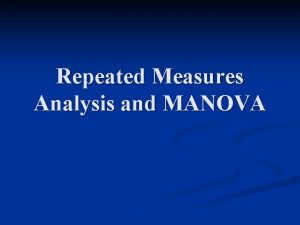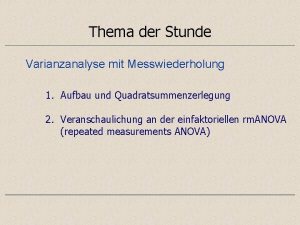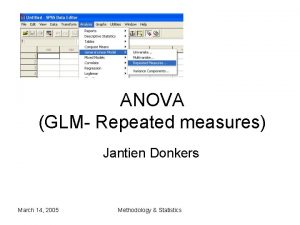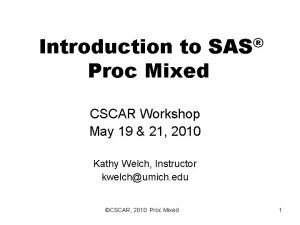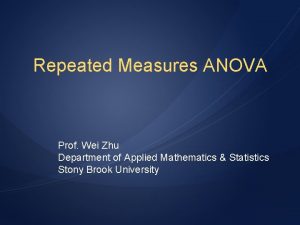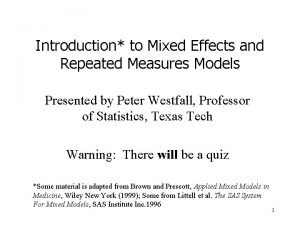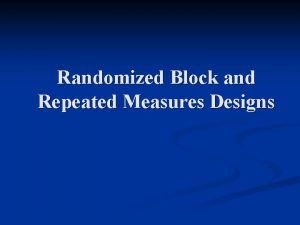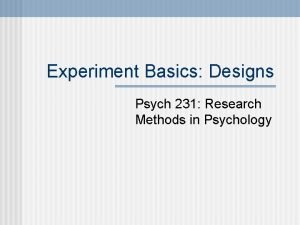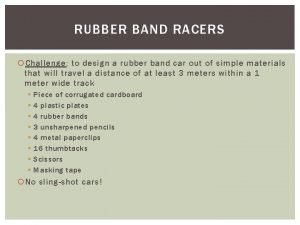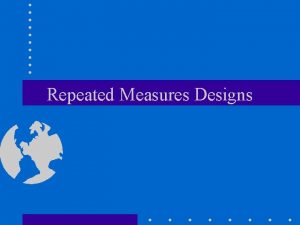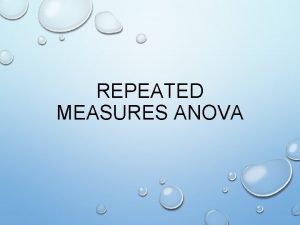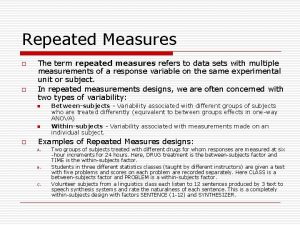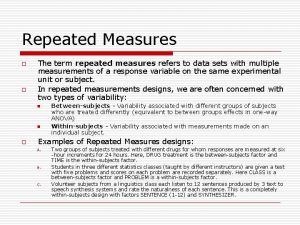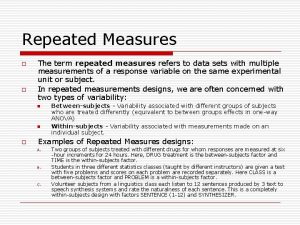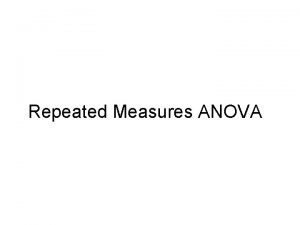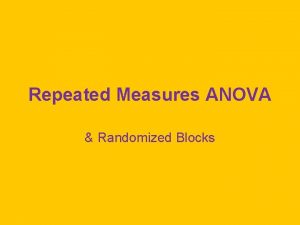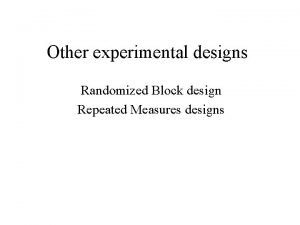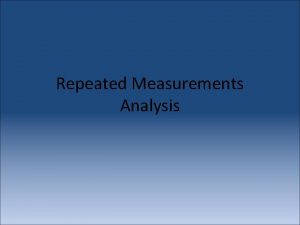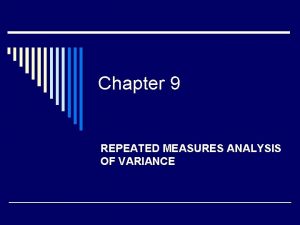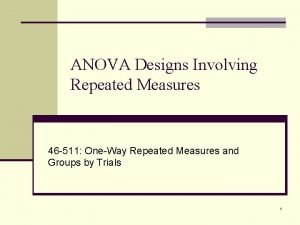Repeated Measures Designs In a Repeated Measures Design









































- Slides: 41

Repeated Measures Designs

In a Repeated Measures Design We have experimental units that • may be grouped according to one or several factors (the grouping factors) Then on each experimental unit we have • not a single measurement but a group of measurements (the repeated measures) • The repeated measures may be taken at combinations of levels of one or several factors (The repeated measures factors)

Example In the following study the experimenter was interested in how the level of a certain enzyme changed in cardiac patients after open heart surgery. The enzyme was measured • immediately after surgery (Day 0), • one day (Day 1), • two days (Day 2) and • one week (Day 7) after surgery for n = 15 cardiac surgical patients.

The data is given in the table below. Table: The enzyme levels -immediately after surgery (Day 0), one day (Day 1), two days (Day 2) and one week (Day 7) after surgery

• The subjects are not grouped (single group). • There is one repeated measures factor -Time – with levels – Day 0, – Day 1, – Day 2, – Day 7 • This design is the same as a randomized block design with – Blocks = subjects

The Anova Model for a simple repeated measures design Repeated measures subjects y 11 y 12 y 13 … y 1 t y 21 y 22 y 23 … y 2 t yn 1 yn 2 y 13 … ynt

The Model yij = the jth repeated measure on the ith subject = m + ai + tj + eij where m = the mean effect, ai = the effect of subject i, tj = the effect of time j, eij = random error.

The Anova Table for Enzyme Experiment The Subject Source of variability is modelling the variability between subjects The ERROR Source of variability is modelling the variability within subjects

The repeated measures are in columns Analysis Using SPSS - the data file

Select General Linear model -> Repeated Measures

Specify the repeated measures factors and the number of levels

Specify the variables that represent the levels of the repeated measures factor There is no Between subject factor in this example

The ANOVA table

The Multivariate Model for a Repeated measures design

The Anova (univariate) Model yij = the jth repeated measure on the ith subject = m + aj + tj + eij where m = the mean effect, aj = the effect of subject i, tj = the effect of time j, eij = random error.

Implications of The Anova (univariate) Model mj = the mean of y ij = m + 0 + tj + 0 = m + tj

The implication of the ANOVA model for a repeated measures design is that the correlation between repeated measures is constant.

The multivariate model for a repeated measures design Let denote a sample of n from the p-variate normal distribution with mean vector and covariance matrix S. Here Allows for arbitrary correlation structure amongst the repeated measures – yi 1, yi 2, … , yit

Test for equality of repeated measures

Repeated measures equal X 1 2 3 … repeated measures t

Let Then

The test for equality of repeated measures: Consider the data This is a sample of n from the (t – 1)-variate normal distribution with mean vector and covariance matrix.

Hotelling’s T 2 test for equality of variables if H 0 is true than has an F distribution with n 1 = t – 1 and n 2 = n - t + 1 Thus we reject H 0 if F > Fa with n 1 = p – 1 and n 2 = n – t + 1

To perform the test, compute differences of successive variables for each case in the group and perform the one-sample Hotelling’s T 2 test for a zero mean vector

Example

Example In the following study the experimenter was interested in how the level of a certain enzyme changed in cardiac patients after open heart surgery. The enzyme was measured • immediately after surgery (Day 0), • one day (Day 1), • two days (Day 2) and • one week (Day 7) after surgery for n = 15 cardiac surgical patients.

The data is given in the table below. Table: The enzyme levels -immediately after surgery (Day 0), one day (Day 1), two days (Day 2) and one week (Day 7) after surgery

Example : (Repeated Measures Design - Grouping Factor) • In the following study, similar to example 3, the experimenter was interested in how the level of a certain enzyme changed in cardiac patients after open heart surgery. • In addition the experimenter was interested in how two drug treatments (A and B) would also effect the level of the enzyme.

• The 24 patients were randomly divided into three groups of n= 8 patients. • The first group of patients were left untreated as a control group while • the second and third group were given drug treatments A and B respectively. • Again the enzyme was measured immediately after surgery (Day 0), one day (Day 1), two days (Day 2) and one week (Day 7) after surgery for each of the cardiac surgical patients in the study.

Table: The enzyme levels - immediately after surgery (Day 0), one day (Day 1), two days (Day 2) and one week (Day 7) after surgery for three treatment groups (control, Drug A, Drug B)

• The subjects are grouped by treatment – control, – Drug A, – Drug B • There is one repeated measures factor -Time – with levels – Day 0, – Day 1, – Day 2, – Day 7

The Model yikj = the jth repeated measure on the ith subject in the kth group = m + ak +ekj (1) + tj + (at)ki + ekij(2) where m = the mean effect, ak = the effect of group i, eij(1) = between subject error. tj = the effect of time j,

(at)kj = the group-time interaction effect eij(2) = within subject error.

The Anova Table There are two sources of Error in a repeated measures design: The between subject error – Error 1 and the within subject error – Error 2

Tables of means Drug Control A B Overall Day 0 118. 63 103. 25 103. 38 108. 42 Day 1 77. 88 68. 25 69. 38 71. 83 Day 2 60. 50 52. 00 54. 13 55. 54 Day 7 55. 75 51. 50 52. 92 Overall 78. 19 68. 75 69. 59 72. 18


The Multivariate approach to this data: • k = 3 samples from 4 -variate normal distribution

Analysis

Example : Repeated Measures Design - Two Grouping Factors • In the following example , the researcher was interested in how the levels of Anxiety (high and low) and Tension (none and high) affected error rates in performing a specified task. • In addition the researcher was interested in how the error rates also changed over time. • Four groups of three subjects diagnosed in the four Anxiety-Tension categories were asked to perform the task at four different times patients in the study.

The number of errors committed at each instance is tabulated below.

The Anova Table
 Anova repeated measures
Anova repeated measures Repeated measures design
Repeated measures design Repeated-measures design
Repeated-measures design Matched pairs design
Matched pairs design Unit 2 ap psychology
Unit 2 ap psychology Dependent variable
Dependent variable Repeated measures design psychology
Repeated measures design psychology Repeated measures design
Repeated measures design Repeated measures design
Repeated measures design Andy field anova
Andy field anova Mixed design anova spss
Mixed design anova spss Manova in jmp
Manova in jmp Quadratsummenzerlegung anova
Quadratsummenzerlegung anova Syntax editor in spss
Syntax editor in spss March
March Proc mixed syntax
Proc mixed syntax Repeated measures anova
Repeated measures anova Mixed model repeated measures
Mixed model repeated measures Repeated measures anova jmp
Repeated measures anova jmp Recurring aspects of designs are called design
Recurring aspects of designs are called design The recurring aspects of designs are called design
The recurring aspects of designs are called design The recurring aspects of designs are called design
The recurring aspects of designs are called design Repeated acquisition design
Repeated acquisition design Partial counterbalancing psychology
Partial counterbalancing psychology Within or between subjects
Within or between subjects What is between and within subjects design
What is between and within subjects design Findings of qualitative research
Findings of qualitative research Waterbottle rockets
Waterbottle rockets Thank you page
Thank you page Greek period floral design
Greek period floral design Rubber band car designs
Rubber band car designs Types of research design
Types of research design Turf areas in xeriscaping designs should be seeded in
Turf areas in xeriscaping designs should be seeded in Experimental design principles
Experimental design principles Premier jewelry home shows
Premier jewelry home shows Soni scilympiad
Soni scilympiad Example of output design
Example of output design Medieval shield colors and their meanings
Medieval shield colors and their meanings Caylua designs
Caylua designs Triangular arch
Triangular arch Pure romance party invite wording
Pure romance party invite wording Hopewell designs
Hopewell designs

